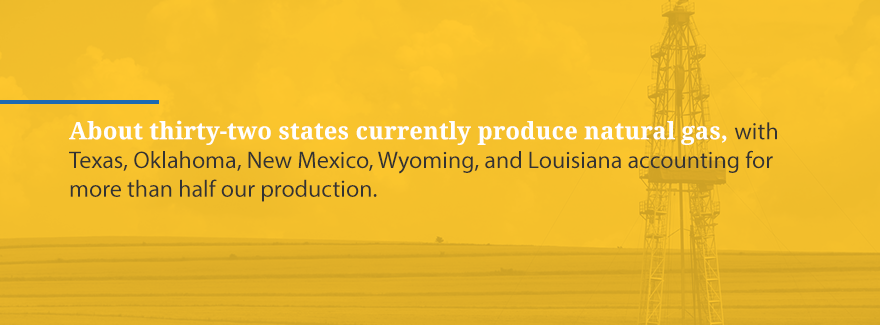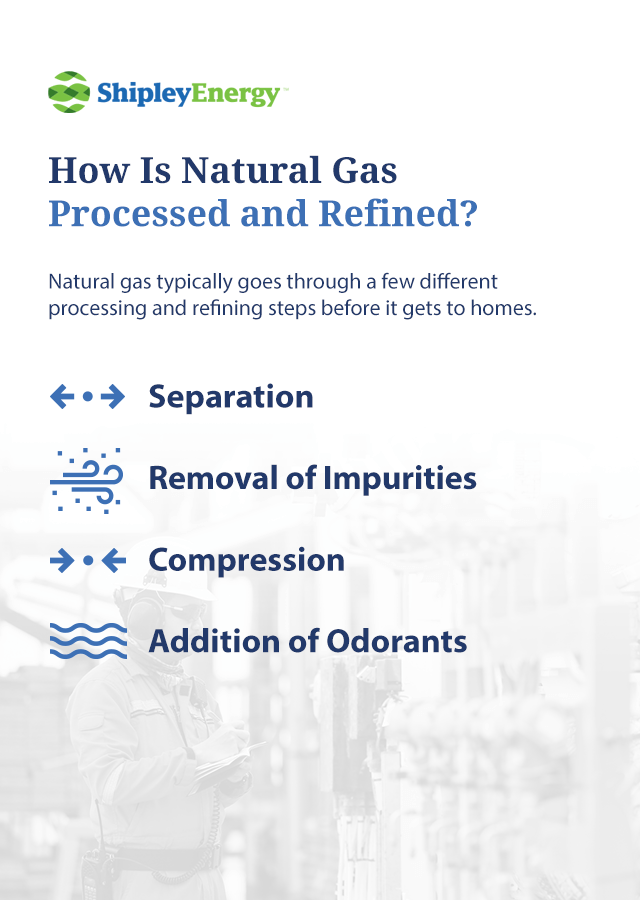
Natural gas is a clean, efficient, and reliable way to heat homes and power essential appliances. But have you ever wondered what it is, where it comes from, and how it gets to you?
If you have, we’re here to give you the answers. In the guide below, we’ll discuss where natural gas is found, how natural gas is made, and how it is converted into energy. We’ll also describe some common natural gas uses in the home.
Natural gas is a source of energy that lies beneath the earth’s surface. Though natural gas contains many different substances, one of its primary components is methane (CH4), which has one atom of carbon surrounded by four atoms of hydrogen. Natural gas is tasteless, colorless, and odorless — what we think of as its characteristic smell is a commercial addition to help warn people of gas leaks.
Apart from methane, natural gas contains other hydrocarbon components and nonhydrocarbon components. A hydrocarbon is any compound composed of both carbon and hydrogen, and these compounds are often found in fuel sources like petroleum and natural gas.
Natural gas contains hydrocarbon gas liquids (HGLs) such as propane, butane, and ethane. These HGLs would be gaseous at atmospheric pressure, but they condense into liquid form at extreme pressures such as those found deep beneath the earth’s surface, or in pressurized containers. Natural gas also contains nonhydrocarbon gases like water vapor and carbon dioxide.
How is natural gas formed? Natural gas formed beneath the earth’s surface beginning millions of years ago, or even hundreds of millions of years ago. During that time, as plants and animals died, their decaying organic matter built up in layers on the surface of the earth and on the ocean floors.
Over many years, new layers of sediment, sand, and rock built up on top of that organic matter. The weight of the new layers compressed the organic material until the pressure and heat buildup below the earth’s surface began to change the organic material’s form. The decayed plant and animal matter turned into coal in some areas, oil in some areas, and natural gas in others.
But the natural gas did not always remain exactly where it had formed — it shifted to new locations. Today, we give different types of natural gas different names depending on the formations in which we find them.
Some of the natural gas moved underground toward the naturally occuring cracks between layers of the surrounding rock. Natural gas found in these cracks and cavities is known as conventional natural gas.
In some areas, natural gas didn’t move into the cracks between layers of rock. Instead, it moved into the tiny pores of certain types of rock formations, particularly sandstone, shale, and other types of sedimentary rock. This type of natural gas is known as shale gas. It is also sometimes called tight gas or unconventional natural gas. Shale gas is more difficult to extract than conventional natural gas and requires techniques beyond conventional drilling.
In some cases, natural gas formed alongside underground deposits of crude oil. Some of these deposits lie deep underground, and some lie far beneath the ocean floor. In either case, this kind of natural gas is known as associated natural gas because it is found in association with crude oil.
In other cases, natural gas formed alongside underground deposits of coal. The type of associated natural gas that formed alongside coal is often called coalbed methane.
Today, natural gas is extracted in the United States and many other countries. Almost 75% of global natural gas reserves are in the Middle East, the former Soviet Union, and Europe. The United States produces about 4% of the world’s natural gas, but that is enough to supply our needs — more than 90% of the natural gas used in the United States comes from domestic sources. About thirty-two states currently produce natural gas, with Texas, Oklahoma, New Mexico, Wyoming, and Louisiana accounting for more than half our production.

One tool geologists use to help locate natural gas is the seismic survey. A seismic survey involves sending seismic waves through the earth, observing their behavior, and using the resulting data to determine the nature of rock formations. Seismic surveys often use thumper trucks, which are large vehicles that use vibrating pads to thump the earth and create seismic waves. They may also use explosives. Seismic surveys of the ocean floor often use bursts of sound to generate sonic waves.
If geologists conclude that an area may hold natural gas deposits, the next step is to drill an exploratory well. An exploratory well allows access to the natural gas so scientists can assess its quality and estimate the volume of gas available.
Natural gas is usually extracted in one of two ways:
In the United States, one large repository of natural gas lies in the Marcellus shale that extends from southern New York, through much of northern and western Pennsylvania, and down into Maryland, Virginia, West Virginia, Ohio, Kentucky, and Tennessee. The United States Geological Survey estimates that Marcellus shale contains about 84 trillion cubic feet of natural gas and an additional 3.4 billion barrels of natural gas liquids.
Currently, pipeline infrastructure is not in place to transport natural gas from Marcellus shale down into southern Pennsylvania. Still, the gas from Marcellus shale remains a crucial natural resource for Pennsylvania and may see much more widespread distribution in the future.
Natural gas typically goes through a few different processing and refining steps before it gets to homes.

When natural gas comes out of the pipeline, it first undergoes separation. This process removes oil and water from the gas. Often, for safety or operational reasons, the gas is then vented and flared — venting releases a small amount of gas into the atmosphere, and flaring combusts gases that would otherwise pose safety hazards. From there, the gas goes to a gas processing center for further refining.
How is natural gas refined? The natural gas that initially comes out of the pipeline is known as wet natural gas because it contains NGLs like ethane, propane, and butane, as well as some water vapor. It also contains other compounds like carbon dioxide, sulfur, nitrogen, and helium. Processing plants must remove most of these compounds — they often sell them separately for other uses.
Once the impurities are gone, the natural gas is known as dry or consumer-grade natural gas. It is then vented and flared once again for safety and sent out along the next pipeline.
From the processing plant, the natural gas typically goes to a series of compressor stations. These are usually located about 50 or 60 miles apart along the gas pipeline. As the gas flows through the pipeline, it loses some pressurization to the friction of traveling along the steel pipes, but the compressor stations compress the gas again so it can flow more easily through the pipeline. At a compressor station, the gas may also go through scrubbing and filtering to remove any lingering impurities.
Natural gas is odorless when it comes out of the wellhead. But an odorless combustible gas is too dangerous for consumers to use — a gas leak might go undetected and lead to serious explosions and fires. So when the natural gas reaches a gate station — a local receiving station that receives gas from several different pipelines and lowers its pressure for distribution — the gate station typically adds odorants to give the gas an unpalatable smell.
Once the natural gas is processed and refined and has flowed through the pipeline to a gate station or distribution facility, it is ready for use. But how does it get from there into consumer homes? Here are the various channels it flows through:
How does natural gas work in a home? Once natural gas enters your home, it still exists in a compressed gaseous state. It becomes usable energy only when ignited. When you turn on a gas appliance, the pressure of the gas is slightly higher than air pressure, so it flows out of the burner. It then ignites in a predictable blue flame, either with discrete electric spark ignition or through a continuously burning pilot light.
Natural gas supplies about 24% of residential energy in the United States, but how is natural gas used in homes?
One of the top uses of natural gas in your home is the heating system, which usually accounts for the most significant share of home energy use. Natural gas heating systems make excellent choices because they are dependable, comfortable, and efficient — the minimum efficiency standard is 78% percent, but some models achieve 90% efficiency.
Natural gas heat is also warmer than electric heat pump heat. Electric heat comes into a home at between 85 to 95 degrees Fahrenheit. But natural gas heat flows into a home at a toasty 120 to 140 degrees Fahrenheit, so it can heat a home faster and more comfortably.

One of the other main uses of natural gas in your home is cooking appliances. Gas ranges are popular with chefs because of the consistent heating, superior temperature control, and instantaneous on and off functions they offer. Homeowners can gain these benefits in their kitchens as well. Gas stoves that use spark ignition rather than a pilot light can also help homeowners save nearly a third on energy costs.
Natural gas commonly supplies the energy needed to power dryers. Natural gas dryers are reliable and efficient, and they tend to produce less static cling, wrinkling, and shrinking than other dryer models. Many natural gas dryers can sense moisture and heat levels and shut off automatically, helping reduce energy consumption.
Natural gas also commonly supplies the energy needed to power a home’s water heater. After the central heating system, the water heater is typically the biggest consumer of energy in the home. On average, a gas water heater is more economical to operate than an electric water heater, and it heats water twice as fast.
Curling up by a cozy fire is one of the best parts of winter, but the work of cutting and stacking firewood, along with building, tending, and putting out a fire, can seem like a chore. That’s why many households invest in gas fireplaces — even tiny apartments without traditional chimneys. Gas fireplaces are convenient, affordable, and efficient ways to create a warm, cozy fire on freezing winter days.
To learn more about our residential natural gas or to switch suppliers, contact Shipley Energy. Throughout the Northeast, customers trust Shipley Energy for our dependable service, value, and years of experience that help us find the best energy solutions for each household’s needs. And if you’re looking to switch to natural gas, we can install the equipment you’ll need for your supply.
Check our rates online, and then contact us today to learn more. You can also give us a call at 855-275-9720.
